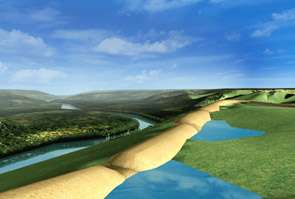What’s Lost Is Found Again: Virtually Rebuilding Our Heritage

Native American cultures that once flourished in Ohio, Kentucky, Indiana and West Virginia constructed geometric and animal-shaped earth works that often rivaled Stonehenge in their astronomical accuracy.
A few are still extant – Serpent Mound in Adams County, Ohio, for example – but most of the region's ancient architecture was all but squandered. Earthworks, from as early as 600 BC that stretched over miles and rose to heights of 15 feet or more, were either gouged out or plowed under in the 19th century or paved over for development in the 20th.
But now, this lost heritage from the Adena, Hopewell and Fort Ancient cultures is returning in the form of a traveling exhibit that will include virtual reconstructions of earthworks from 39 sites. The electronic recreations represent nearly ten years of work by an extensive team of architects, archaeologists, historians, technical experts and Native Americans. Project director is John Hancock, professor of architecture at the University of Cincinnati, working in partnership with the Center for the Reconstruction of Historical and Archaeological Sites (CERHAS) at the University of Cincinnati. The title of the project and the coming traveling exhibit is: "EarthWorks: Virtual Explorations of the Ancient Ohio Valley."
The "EarthWorks" reconstructions will be the centerpiece within a 500-square-foot traveling exhibit which will also include a graphic timeline wall with cross cultural comparisons; a giant map wall of the Ohio River Valley (from the approximate location of Pittsburgh to Louisville) indicating placement of Native American earthworks; panels with diagrams, photos and text; and 3-D topographic models of five earthwork sites. The exhibit opens June 20, 2006, at the Cincinnati Museum Center. It remains at the museum center till Sept. 7, 2006. Later venues include the Ohio Historical Center, Columbus, opening on Sept. 30, 2006. Discussion are now underway for later exhibits in the state and nation.
Set amid the physical elements of the exhibit, the 3-D virtual reconstructions by Hancock and his team recreate the earthworks for school children and scholars alike. The centerpiece of the exhibit is a large screen on which the 3-D explorations of "EarthWorks" by a user at the touch-screen computer can be shared with a larger audience. Virtual exploration of a gallery of period artifacts is also possible at two stand-alone kiosk stations.
The project is built upon archaeological data gleaned from such modern technology as sensing devices and aerial photography as well as frontier maps and other aids provided by archaeologists to re-establish the location, size, shape and appearance of many of the region's earthworks. Then, using architectural software and high-resolution computer modeling and animation, the UC-led team virtually rebuilt these massive structures and further created animated, interactive, narrated "tours" among them.
Source: University of Cincinnati
















